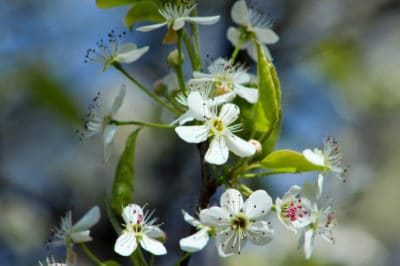Invasiveness
Throughout much of North America planting Bradford Pear is not recommended. Many varieties have naturalized and become invasive to native ecosystems. Nurseries still sell non-fruiting varieties of the Bradford.
It is very easy for these trees to cross-pollinate with a naturalized variety and produce fruits. These fruits spread by birds and will sprout. The offspring that is produced will be an older fruiting variety.
Blossoms
This pear tree grows tall and dense. They can reach heights of 30 feet with a spray of branches. The white blossoms come in May and decorate the landscape. The trees are packed with small five-petaled flowers.
They are stunning to look at but have an undesirable odor. Many describe the scent of a Bradford pear blossom as ‘fishy.’ They attract beneficial insects and can help an orchard with pollination.
These pear trees are not self-pollinating. They require another nearby variety of Callery pear in order to fruit.
Uses and Care
The fruit of the Bradford pear is not edible. It is a small, round fruit with a tough russet skin. The flesh is woody, and it softens after a frost. Once soft the birds will readily gobble it up.
They are known for growing branches at narrow angles off of the trunk. This makes for weak crotches that tend to break in storms. To keep Bradford pears from breaking, the tree should be pruned early in life. Continue with regular prunings to remove dead wood and weak branches.
Despite some convenient uses, the Bradford pear has fallen from popularity.
- Blight resistance: The Bradford was originally prized for being resistant to blight disease. For this reason, it makes an excellent rootstock for edible pear varieties. Well-known pears like Bosc, Comice, and Seckel can be grafted onto Bradford rootstock.
- Hardwood: Pear wood is among the finest hardwoods available. It is commonly used for producing wind instruments.
- Ornamental: It is mostly planted as an ornamental.
What To Do With A Bradford Pear?
Not many people are planting them anymore due to their invasiveness and less than perfect qualities. For the same cost and level of care, gardeners can plant an edible pear tree that is still beautiful in the springtime.
If you happen to have a Bradford, don’t be too hasty to pull it out either. These trees offer beauty, blossoms, and history to the landscape.
